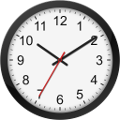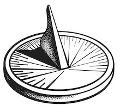|
Why Is It That Clocks Go Clockwise? Clocks, at least the ones that are not digital and still show hour and minute hands, turn in one direction, clockwise. That is sort of a circular argument, though: What direction does a clock turn? The answer is clockwise, which is a word that means "the direction a clock turns." 
The more accurate question is this: Why do the hands on a clock turn the way that they do? The answer has its roots in ancient history. One of the first devices used to keep track of time was the sundial. A sundial was sometimes wood, sometimes stone, but always consisted of a circular platform in the middle of which was a vertical stick or lever called a gnomon. The sundial was designed to capture shadow resulting from sunlight that shone on the platform, in particular the gnomon. In the Northern Hemisphere, the shadow moved on a sundial from north to east to south to west, in exact opposition to the turning of of the Earth on its axis, as viewed at the North Pole. The way that maps are most often portrayed is that north is at the top, so a shadow moving from north to east would move from top downward to the right, then downward more toward the bottom of the circle (south), and then on around and back up to the left (west), and then ending back on top (north again). 
Maps showing lands in the Southern Hemisphere are still most often portrayed with north at the top. However, a sundial in the Southern Hemisphere would show the shadow cast by the Sun moving counterclockwise (or, to some cultures, anticlockwise), or in the opposite direction from the way in which a Northern Hemisphere's sundial would move. A Southern Hemisphere sundial would move down and to the left and then up and to the right. The first clocks that were developed in the Middle Ages were developed in the Northern Hemisphere, and so the the hands on those clocks mimicked the actions of the shadow around a (Northern Hemisphere) sundial, so down and to the right and then up and to the left. As to how people referred to these directions before the advent of clocks, many scholars think that early peoples used the word "sunwise" and the word "deasil" or "deosil" (both from the Scottish-Gaelic language tradition) to refer to what we now say is clockwise, or the way in which the sundial followed the Sun (in the Northern Hemisphere). Some traditions also say that the pre-clock word for counterclockwise or anticlockwise was widdershins, a German word that meant "opposite course." Have a suggestion for this feature? Email Dave. |
Social Studies for Kids |





